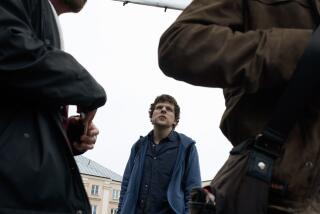Review: ‘The Art of Self-Defense’ takes violent comic aim at toxic masculinity
By now it should be clear that we underestimate Jesse Eisenberg at our own peril. His characters are often walking demonstrations of this principle: Think of the Harvard elites who scorned his young Mark Zuckerberg in “The Social Network,” or the assassins who made the mistake of taking on his stoner Jason Bourne in “American Ultra.” Eisenberg excels at playing an easily dismissible type — the nebbish, the misanthrope, the loner — but within that type he often discovers a startling range of emotional notes, triumph and exhilaration included. His performances are a reminder never to count him out.
The lesson is delivered again, perhaps definitively, in “The Art of Self-Defense,” an unnerving, exacting dark comedy set at the crowded juncture of masculinity and violence. Written and directed by Riley Stearns, the movie stars Eisenberg as Casey Davies, a mild-mannered accountant and amateur Francophile who is shunned by most of his co-workers and has no friends besides his pet dachshund. His tidy brown-and-beige apartment speaks to a dully ordered existence, one that is viciously upended when he goes out for a walk one night and gets mugged and beaten by masked thugs on motorcycles.
As he recovers from the assault, Casey considers buying a firearm, making a brief stop at what you might call Chekhov’s gun store. But he thinks better of it and heads instead to a nearby dojo, where he dons a white belt and begins studying karate under a smoothly charismatic sensei (a terrific Alessandro Nivola), who fixes Casey with a thin little smile and tells him, “I’m really glad you’re here.” It’s a line that sounds both welcoming and faintly sinister.
Casey’s fellow students vary in expertise: There’s Henry (David Zellner), a friendly blue belt who shows him the ropes, and Anna (Imogen Poots), a fierce red belt who is notably the only adult female in the dojo. Their devotion to this training space feels peculiar in its intensity, as does their covetous desire for their sensei’s approval. Casey will soon join their ranks: Despite his physical awkwardness and lack of experience, he has a talent for dedicated self-improvement and soon earns a yellow belt, establishing himself as the hot young newcomer in this shadowy enclave.
Much of the pleasure of “The Art of Self-Deception” comes from its sly derangement of a familiar dramatic template, the motivational get-in-shape movie. Karate experts can either take offense or delight in the way Stearns merges the rigors of martial arts — the attention to etiquette and technique, the hierarchies imposed by belt stripes and colors — with a controlled surrealism that becomes weirder and more menacing by the minute.
In that sense, Casey’s gullibility makes him a bit like the fabled frog being slowly boiled alive: He loves this enclosed, well-structured world and gladly absorbs every one of its rules and rituals, not realizing exactly where he is and what he’s become until it’s far too late for him to extricate himself.
But the dojo isn’t the only environment where everything seems curiously off-kilter. It’s unclear exactly when the story is taking place, given the old-school answering machine in Casey’s apartment and the camcorder and VHS tapes that figure into the plot. (The excellent production design, all drab interiors and muted colors, is by Charlotte Royer.) The characters’ speech patterns are even more disorienting: Everyone here speaks in complete sentences, an amusing formality that draws the most attention to itself in the case of, well, Casey, as Eisenberg rattles off every line, word and syllable like the star pupil in a speech and elocution class.
It’s the kind of almost-alienating touch that might have seemed like quirky indie mannerism, an attempt to outdo the stilted, declarative cadences of Yorgos Lanthimos (“The Favourite”). But it dovetails neatly with Stearns’ obsession with codes and rituals, set in a world in which violence and chaos like to hide behind the appearance of order. Stearns made his directorial debut in 2014 with “Faults,” a chillingly astute drama that showed its own fascination with personality cults and the slippery nature of reality. In this movie, he uses an absurdist approach to language to expose the absurdity of the ideas and systems to which our society too often clings.
The words “toxic masculinity” are never spoken, though they would be redundant in a movie where the sensei articulates — perhaps a bit too precisely — his retrograde notions about how men and women are supposed to behave. As the sensei, Casey and Anna are ensnared in an eerie psychological triangle, “The Art of Self-Defense” becomes an unambiguous satire of chauvinistic cruelty and pure, motiveless bloodlust. Will Casey, once a victim of that culture, become one of its enforcers or one of its challengers?
The answer isn’t entirely clear at first, which is a good thing. With icy deadpan control, Stearns walks a perilously thin line between the provocative and the preposterous, courting your shock as well as your laughter. The more the shape of the story comes into focus in the final stretch, the less intriguing it becomes, although Eisenberg’s verbally and physically adroit performance never loses its unpredictable edge. Like any good martial artist, he knows just how to keep you off-balance.
------------
‘The Art of Self-Defense’
(In English and French with English subtitles)
Rated: R, for violence, sexual content, graphic nudity and language
Running time: 1 hour, 44 minutes
Playing: Arclight Cinemas, Hollywood
[email protected] | Twitter: @JustinCChang
More to Read
Only good movies
Get the Indie Focus newsletter, Mark Olsen's weekly guide to the world of cinema.
You may occasionally receive promotional content from the Los Angeles Times.











